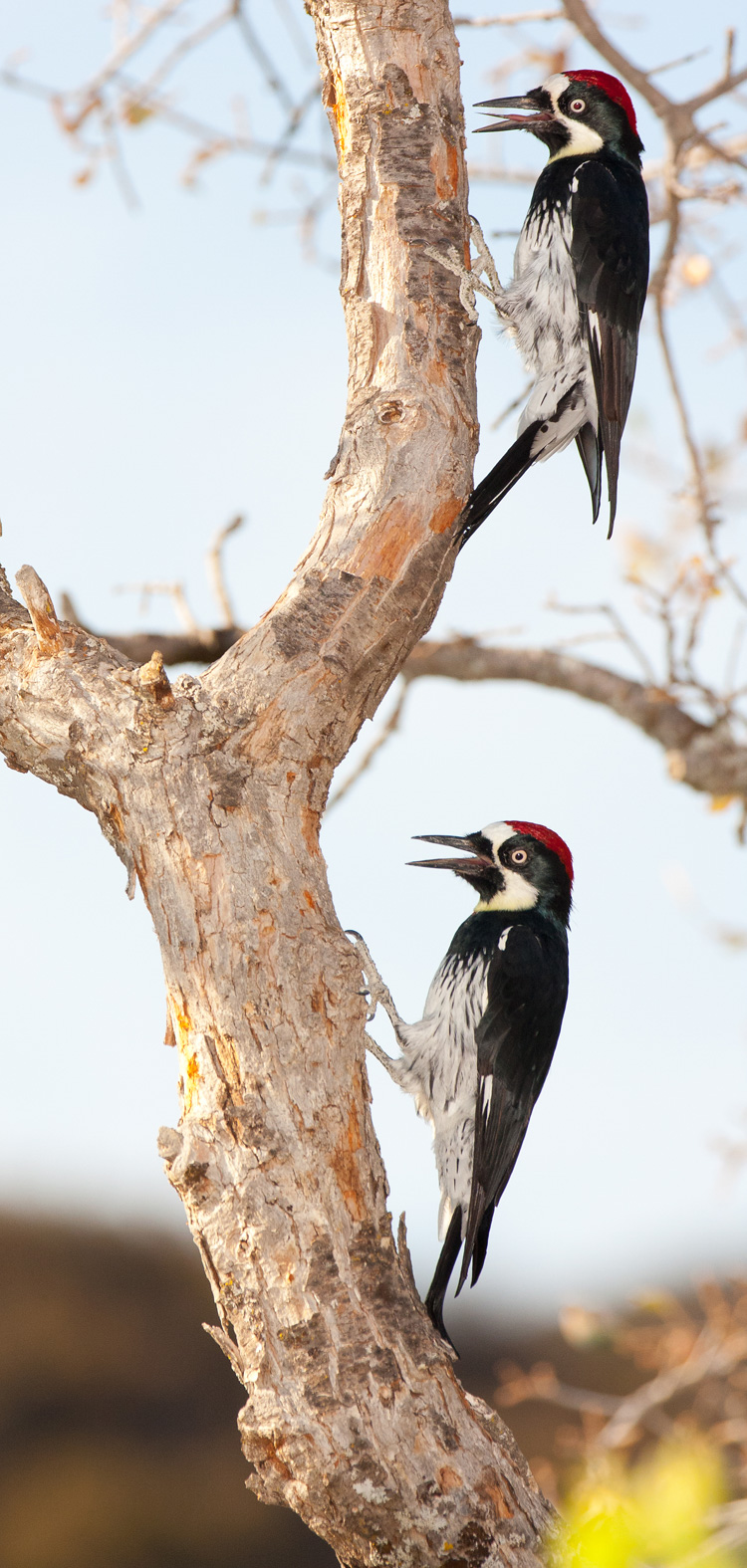Fall is a good time to be on the watch for acorn woodpeckers, those raucous, clown-faced denizens of California’s oak woodlands. If you don’t know them by sight, listen for their loud “waka” or “urrrk” calls or the jackhammering of their bills as they store acorns for the winter. An autumn increase in hammering might tell you the acorn crop is ripe or even that a storm is on the way.
“These acorns are stowed away before the rainy season,” wrote ethnographer Stephen Powers in 1877, drawing on Pomo Indian knowledge. “[W]hen a rain-storm is brewing, the woodpeckers fall to work with great industry a day or two in advance. . . . During the winter, therefore, whenever the woods are heard rattling with the pecking of these busy little commissary clerks . . . , the Indian knows a rain-storm is certain to follow.”
You probably don’t want to abandon your favorite weather forecaster, but you will be richly rewarded any time you tune in to these colorful, quirky birds. Walt Koenig, an indefatigable zoologist who has been studying them for 35 years, says acorn woodpeckers may have the most complex social structure of any vertebrate in the world, humans included. That’s because they do almost all the important stuff–food, marriage, sex, and childrearing–communally.
Flying ants and other flying insects are the woodpeckers’ preferred food, but such insects disappear in late fall, so the birds begin storing acorns as soon as the nuts mature. After tugging acorns off twigs, they pound them pointy-end first into finger-size holes in oak snags, dead limbs, or thick conifer bark. All clan members share the work of drilling holes, caching acorns, and moving the nuts to smaller holes as the acorns dry and shrink, and all have equal rights to the provender. A clan’s granary can contain up to 50,000 acorns.

Clans include up to three breeding females, up to seven breeding males, and usually a few non-breeding adult offspring who stick around and help their parents for up to five years (in spite of reaching sexual maturity at one year of age). In a rare reproductive arrangement known as “polygynandry,” each breeding bird attempts to mate with all opposite-gender breeders in the clan. Their “marriages” last for life, and no new bird may join the marital community until the last breeder of its gender has died.
Hard on the tail of cooperative mating comes nest sharing, though it’s not all harmony at first. To ensure their own chicks will have a good crack at survival, females whose eggs are not yet viable grab the first eggs dropped by their nest sisters and set them out on a branch to be eaten by any member of the clan–including the bird who laid it. Once all the females are ready to lay, the eggs stay put in the nest, and the breeders, male and female, join forces to sit on eggs and catch insects for the babies. The non-breeding helpers also feed the nestlings, significantly increasing the chicks’ chances of survival.
Meanwhile, the adult helpers, who can’t mate with their relatives but risk starvation if they leave the security of a granary, fly multiple missions each day to nearby clans looking for breeding openings. Female helper “Gabrielle” might fly to another clan’s headquarters and call “waka, waka, waka!” in greeting. If “Carol,” the remaining breeding female of that clan, fails to show up and greet her in return, Gabrielle will stay and attempt to become the new breeding female.
But if helper “Sandra” from another clan zooms in and sees Gabrielle in Carol’s place, she might start a noisy fight for the breeding position, chasing and colliding with Gabrielle, sometimes causing both combatants to plummet to the ground. If neither wins, each will recruit her clan sisters to help. The largest coalition usually wins the brawl, which may last a week or more. Male helpers engage in similar battles, though usually with less intensity.
In the autumn of prolific acorn years, the woodpeckers sometimes produce second broods. Listen for the “squee!” or “trtrtr!” of babies audible from nest cavities through the end of October. Next April or May you might see those same chicks, now young adults, lined up under a tree hole waiting to feed insects to three to seven new siblings.





